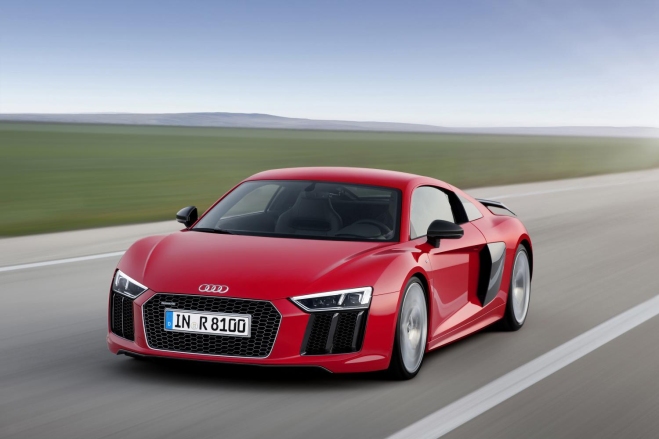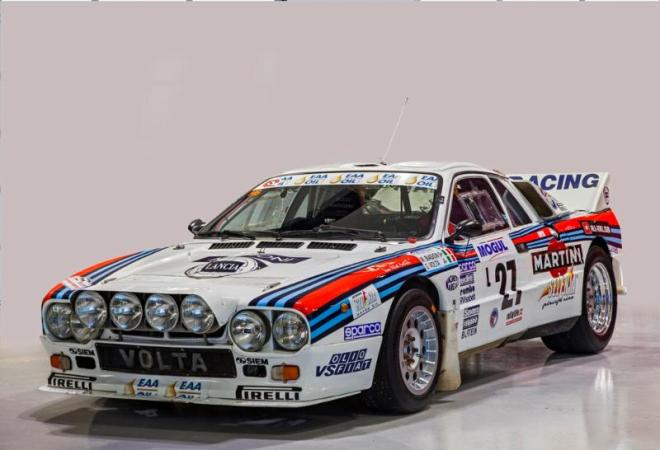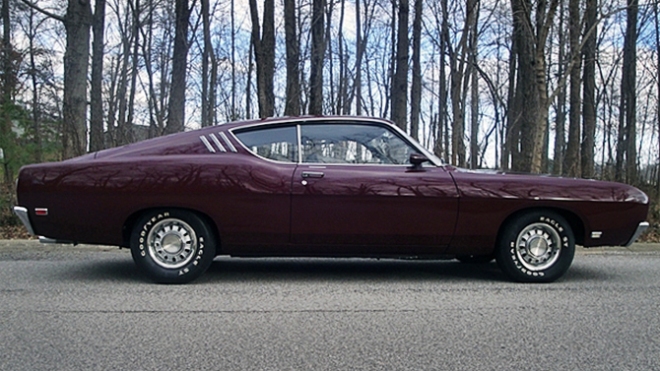Traverse City, December 7, 2022 – Hagerty (NYSE: HGTY), an automotive lifestyle brand and a leading specialty insurance provider, today announced its 2023 U.S. Bull Market list, an annual collection of enthusiast cars and vehicles with the best potential to hold or increase in value in the coming year. In its 6th year, the list is compiled using data from public and private sales, insurance valuations and historical trends. Continue reading
Category: All Cars (Page 1 of 14)
Whitley, UK, 14th April, 2014: Jaguar Land Rover will launch its new Land Rover Heritage division at the Techno Classica show in Essen, Germany between 15-19 April, 2015.
Complementing the recently established Jaguar Heritage division, Land Rover Heritage will offer original Land Rover vehicle parts for a variety of heritage models that have been out of production for longer than a decade.
Body, trim and extended servicing items are available for Range Rover Classic, while for Range Rover P38 and Discovery 1 and 2, Land Rover Heritage supplies salvage and extended service parts to ensure customers’ cherished cars are maintained to the highest possible standard.
For Series l, ll and lll, selected Land Rover Heritage Parts are available and the brand will gradually reintroduce more original part numbers – all made using original tooling methods and all items supported under warranty*.
Land Rover Heritage forms part of Jaguar Land Rover’s Special Operations division and has been created to support the brand’s passion in nurturing and preserving its rich heritage of vehicles and supporting its loyal customer base across Land Rover’s global sales network.
With production of current Defender now in its final phase, Land Rover has committed to supply replacement parts for 15 years for this automotive icon. Thereafter, owners of the current Defender will be able to maintain their treasured car by ordering genuine Land Rover Heritage Parts through Land Rover’s global network of retailers.
John Edwards, Managing Director of Jaguar Land Rover Special Operations, said: “We are delighted to launch Land Rover Heritage, which perfectly complements the recent introduction of Jaguar Heritage. It is estimated that 70% of all Land Rovers manufactured since 1948 are still in existence so there is a large and very passionate owner base to support through Land Rover Heritage.”
The centrepiece for Land Rover at Techno Classica will be an iconic first-generation Range Rover Classic, featuring a selected range of Land Rover Heritage Parts created using original Land Rover tooling.
The steady rollout of the Land Rover Heritage business will also expand to include Land Rover Heritage Drives – launching this summer. This will give participants the unique opportunity to drive models from Land Rover’s heritage collection at a special 200-acre testing facility in Warwickshire.
*Warranty terms may vary. Please consult the nearest Land Rover retailer in your market for specific Terms & Conditions.
After a successful haul in our $2,000,000 Amelia Island Challenge, we’re heading south to the Auctions America sale in Fort Lauderdale. Our Petrolhead Godmother continues with her generosity; this time with $1,000,000 to play with this weekend. Using Auction America’s HIGH estimate, choose one or choose several cars (no motorbikes or automobilia) that you would like to bring home. We’ll get started:
Lot 108 — 1973 Peugeot 504 Cabriolet
Estimate $30,000
UPDATE: SOLD FOR $13,500 including premium
Featured in a Pick Of The Day last year, this is an presentable example of a car rarely seen on these shores. While it shows signs of wear and previous body repairs, this Peugeot 504 has had recent paint and is a complete example of a classic Pininfarina styling.
Lot 177 — 1978 Aston Martin V8 Volante
Estimate $150,000
UPDATE: SOLD FOR $151,250 including premium 
Not much information is in the catalog beyond the history of the V8 as a model, but this looks to be a rather tidy example, complete with books and tools. Although it is an automatic, it would still make for some very pleasant open touring.
Lot 226 — 1989 Porsche 911 Turbo (930)
Estimate $85,000
UPDATE: SOLD FOR $82,250 including premium

Although we aren’t given an odometer reading other than its condition belies the miles, this looks to be an excellent original example of a one-year-only 5-speed 930. Its high estimate would appear to be a bargain relative to other 1989s in like condition (not to mention the 1976 model that runs earlier in the day, estimated at $200,000).
Lot 317 — 1935 Ford Model A “Ratrod’ Pickup
Estimate $40,000
UPDATE: STILL FOR SALE high bid $26,000
This is another one of those lots that we’d chase only when Petrolhead Godmother is footing the bill, but that said, it is dandy. Powered by a 350 V8, its steel body has been chopped, stanced, channeled and dropped. Period wheels and tires cover front disc brakes. A very nicely built blend of bootleg-era looks and contemporary performance.
Lot 356 — 1949 Cadillac Series 61 Club Coupe Sedanette
Estimate $65,000
UPDATE: SOLD FOR $55,000 including premium 
The C-Body Cadillacs of 1948 and 1949 brought together big advances in engineering with the overhead-valve V8 and alluring looks. Here we see the first nubs of Harley Earl’s tailfins punctuating a sleek and graceful body, particularly in the fastback “Sedanette” form. This one form 1949 was a former barn find restored to its current condition with a rebuilt original drivetrain. It’s a positively gorgeous American cruiser that is said to drive quite well.
Lot 472 — 1981 Renault R5 Turbo
Estimate $75,000
UPDATE: SOLD FOR $49,500 including premium 
The Renault R5 Turbo is in many ways an answer to a question no-one was asking. It’s a completely insane answer, yet it makes perfect sense at the same time. Take a pedestrian Renault R5 (what we might remember as Le Car) and transform it into a mid-engined beast that eats supercars for breakfast. This example looks to have been restored at some point to what appears to be a high degree, yet appears to have been used as intended which is to drive the merde out of it. What’s not to love?
Lot 486 — 1989 Lamborghini Countach 25th Anniversary
Estimate $425,000
UPDATE: STILL FOR SALE high bid of $320,000

Petrolhead Godmother always says, “if you get thrown from a bull, get right back on.” We missed out on the Lamborghini Countach 5000S Quattrovalvole at Gooding and Company’s Amelia Island sale earlier this month, thus we’re somewhat compelled to try again. This time it’s the ultimate expression of the Countach, the coveted 25th Anniversary model. This one shows beautifully in its classic Italian combination of red on tan. With a recent service and less than 21,000 km, it promises to be appropriately raging.
Lot 622 — 1948 MG TC
Estimate $52,000
UPDATE: STILL FOR SALE high bid $37,500 
Few capture the charm of early British motoring the way an MG TC does. Future TDs and TFs were already becoming too modern. This one from 1948 has been used sparingly since undergoing an older high quality restoration. It condition remains show worthy, but this little thing begs to be thrown on the open road, only stopping for a picnic. The Clipper Blue finish is a nice departure as well.
We came to a total of $922,000. Buyer’s premiums will put us slightly over the million dollar mark, but once again we’ll err on the side of excess when spending the Petrolhead Godmother’s money. Let us know what your picks are in comments.
For the complete Auctions America Fort Lauderdale 2015 results click here.

| VIN | 228871N125628 |
| Exterior | [11] Cameo White |
| Interior | [211] Blue Knit Vinyl |
| Motor | [LS5] 455 c.i. (7.5 L) V8 rated at net 310 bhp (335 gross) |
| Gearbox | [M40] 3-Speed Automatic |
| Exterior Condition | Very Good (2) |
| Interior Condition | Excellent (2+) |
| Drivetrain | Excellent (2+ ) |
| Tires/wheels | Excellent (2+) |
AS ONE ERA ENDS, ANOTHER TAKES FLIGHT. Although it never had the opportunity to compete in its namesake racing series, the Pontiac Firebird Trans Am brought the manners which made for a successful road-course car to the highways and byways. With an emphasis toward greater downforce, the Trans Am favored handling over the straight-line speed that dominated the end of the muscle car era. At the time of its mid-1969 introduction, the horsepower wars were at their peak. Pontiac was well in the mix with the Ram Air 400s, but the writing was already on the wall. Federal safety and emissions regulations were looming, taking most of the muscle out of the muscle-car era. Rather than abandon a market still coveting V8 performance, Pontiac compensated for a lower compression ratio—brought on by unleaded fuel requirements—through more cubic inches and improved breathing. For 1971, they introduced the 455 HO to the second-generation Trans Am. Though its gross horsepower was still shy of the Ram Air 400, the 455 HO—combined with the TA’s aero kit—was, as Pontiac Engineers called it, “the beginning of tomorrow.” Prophetic words, as the Trans Am lived on into the next millennium, finally ending its run in 2002.
This 1971 Pontiac Firebird Trans Am (No 25628) is an extraordinary original example, benefiting from only two passionate owners; the second and current owner having owned the car for 38 years. Throughout that time it has garnered awards and even achieved a moment of stardom in the Paramount Pictures comedy Anchorman 2. Yes, it’s kind of a big deal. The car has excellent documentation with a complete PHS report as well as owners manual, sales brochure, and print ad. With over 95,000 miles on the clock, it’s no garage queen. Having said that, it has always been garaged and currently resides in a state-of-the-art collector car storehouse. The attention to preservation and detail radiates in every aspect:
EXTERIOR is excellent with a straight, absolutely rust-free body. Its Cameo White paint shines, glass-smooth and completely original, with no repaint, no respray, and no touch-up. Ever. It wears a few minor pits and chips on its chin and flares (pictured) as a testament to a long, exceptionally well-cared for, well-preserved life, but otherwise looks admirably unblemished.
INTERIOR is near flawless, showing very little wear to its Blue Knit vinyl upholstery. Only the padding of the center console shows some cracking, but again, it is what the car was born with. No cracks in the dash, no scuffs in vinyl, and no snags in the knit. The Trans Am’s distinctive engine-turned dashboard is brilliant and unmarred. Carpets are fresh and clean with aftermarket floor mats, though the original ones come with the car, as does the original AM/FM radio, which was swapped for a more “modern” cassette unit shortly after it changed hands in 1978. It’s a car that was biased toward performance over creature comforts. Thus, in an effort to “add lightness and simplify,” few other options were checked at the time the car was ordered by the original owner:
| FACTORY OPTIONS | A90 | Deck Lid Control | B18 | Custom Trim Group | B32 | Front Floor Mats | B93 | Door Edge Guards | D55 | Front Console | N41 | Variable Ratio Power Steering | P05 | Honeycomb Wheels | U69 | AM/FM Radio |
DRIVETRAIN is exceptionally strong with its smooth running 455 c.i. V8 and, while it lacks the personal connection of the M22 4-speed, the Turbohydramatic 400 is very well mated to the HO’s 480 lb/ft of gross torque. The gearbox shifts surely without any lurching or slips, even when shifting manually. This harmony between motor and transmission elevates the driving experience to a point where a manual is seldom missed. The variable-ratio power steering is positive, with no slop and excellent feedback at higher speeds or under cornering. Because the current owner is a master mechanic, any potential issue was addressed long before it may have affected the life of the drivetrain or any of its vital parts. As such, there’s an integrity to its mechanical performance that feels very much as it might have at delivery.
BRAKING AND SUSPENSION are two of the areas where the second-gen Trans Am set the stage for the aforementioned “beginning of tomorrow.” In addition to the road-holding provided by the aerodynamics, the suspension featured thick anti-sway bars front and rear, as well as heavy duty shocks and a limited-slip differential (Safe-T-Track in Pontiac parlance). No 25628 currently rides on near-new Goodyear Eagle GTs for added grip and a softer ride, however a set of correct Polyglass F60-15s are available.
With only 2,116 Trans Ams produced in 1971 (1,231 of which came with the TH400 automatic), finding one in any condition is out of the ordinary. Finding one in excellent original condition, well, that is a rare bird. The 1971 Pontiac Firebird Trans Am was the bridge that spanned the brute muscle of the ’60s and what would ultimately define the muscle car of the ’70s. A relative bargain priced at $49,950.
BY PETER TENGERDY
Once again, Jeremy Clarkson, presenter and top motormouth of BBC’s Top Gear, has—allegedly—gone over the line. This time, however, he’s been black-flagged indefinitely, pending an investigation. With it, the program that draws some 350 million viewers in 170 countries has been shelved; at least for this weekend and, with only one other episode remaining, likely the season. Whether or not it’s true that he punched a producer over a disagreement about his supper is beside the point. Just as it is beside the point whether he mumbled a racial slur in an outtake or riled Argentines with an offensive number plate on purpose, etc., etc. Top Gear’s success is due in no small part because it goes over the line. The antics and often sophomoric behavior are precisely what set it apart from a typical petrolhead show. Much of that is what Mr. Clarkson brings to the mix. One needn’t look any further than the knock-offs and geographic franchises to see that the Clarkson-Hammond-May symbiosis is the one that works. Remove any one and it suffers, but—no disrespect to Mr. Hammond and Mr. May—remove Mr. Clarkson and it becomes another imitation of itself. It is the purity of his journalism combined with his buffoonery that the BBC shells out over £1 million for every year in order for audiences to tune in and grow. The Save Clarkson petition that began circulating immediately after news of the “fracas” broke is evidence that he has built a messiah-like following. It is without question a case of getting what they asked for. Having said that, we’ve all too often seen where that sense of entitlement becomes an abuse of power and the BBC is well within their imminent rights and ethical tenets to reign that in or cut it loose.
The obvious question then is what happens next. Pending the outcome of this latest investigation, if Mr. Clarkson is found not to be at fault, it’s business as usual and the corporate suits return to the edge of their seats to see what he may do next. In the case of at-fault, a simple reprimand would be virtually the same, essentially condoning questionable behavior in exchange for ratings. The supposed tension that has been afoot for the past few years proceeds as the price of success. If however, the BBC carries through with their “one more slip…” threat from the last incident, Top Gear’s future is precarious at best. There simply isn’t anyone who could fill the void of that missing cog. Tiff Needell (@tiff_tv) could return, but in all honesty he has built a better imitation with Fifth Gear than the imitation of “another” Top Gear. Chris Harris (@harrismonkey) may be the best presenter on the Internet and has the boy-loves-car character that is shared with Mr. Clarkson, but it would be more engaging to watch him smoke the tires off a McLaren P1 than ride through Viet Nam with a colander on his head. Maybe. The point is, it too would be an imitation of itself or worse, just another car show.
The simple reality is that television shows come to an end, no matter how good or successful: Breaking Bad, The Sopranos, Seinfeld, and anything by Aaron Sorkin. In this case, the end came abruptly and loyal viewers will be denied the last part of the current season. At least for now. The BBC will be just fine. Mr. Hammond, Mr. May and yes, Mr. Clarkson will be as well. Perhaps he’ll find a lucrative home on the Internet or satellite radio. Or there’s always a judge spot on Britain’s Got Talent.
If you’ve watched or participated in any of the /DRIVE eBay challenges on YouTube, you know how this works. In this case, your Petrolhead Godmother just plopped $2,000,000 USD in your lap to spend as you like at this weekend’s auctions during the Amelia Island Concours d”Elegance. Using the auction companies’ HIGH estimates, pick one or pick several cars (no motorbikes or automobilia) that you would like to haul home. We’ll get started:
From Bonhams – Thursday, March 12
Lot 118 — 1962 Austin Healey 3000 MK II BT7 2+2
Estimate $50,000-$60,000
UPDATE: SOLD FOR $51,700 including premium

In recent years, Big Healeys have gone through a bit of a downturn after a sharp rise in the mid- to late-2000s. Within the last year or so, the market has caught up. It appears now to have made the corrections and adjustments such that they’re realistically priced, vis à vis a Series 1 E-Type on one end of the spectrum and say an MGB at the other. Among the Austin Healey 3000 MKs, many find the middle-gen MK II the most appealing, particularly in the 2+2 BT7 configuration. The MK II had the shortest production run and was an ideal bridge between the rawness of the MK I’s triple carburetors, along with a classic oval dash, and the MK III’s refinements (roll-up windows and a wraparound windscreen). This example radiates its British Roadster-ness, with the Old English White paint over Red interior. It is said to have had a thorough restoration in the late 2000s (just as the market flattened) and reports to be an excellent performer with a strong motor and 4-speed overdrive gearbox. Bonhams estimate of $50-60K is right on the money.
Lot 168 — 1912 Peerless Model 60 Runabout
Estimate $250,000-$350,000
UPDATE: SOLD FOR $440,000 including premium

It may be the type of car that we pursue only when someone dumps $2M in our laps (or we have a discretionary $350,000 laying around), but given such an event, a Peerless Runabout would certainly be one to go after. Among its superlatives are first to offer electric headlamps, first to offer an electric starter, and, in the case of the Model 60 presented here, most cubic inches ever stuffed under an American-made hood (824). The Peerless Model 60 was arguably the fastest thing on the road in the Brass Era. This example was resto-mod’ed in the ‘60s. In that process, some liberties were taken to improve the car’s drivability. These include a shortened chassis, as well as modified steering and brakes, along with coachwork enhancements that give it the Runabout appearance of a 45-hp Model 32 whilst retaining the 66-hp 13.5-liter lump. So while not original, it is a gorgeous representation of motoring’s earliest days and carries with it some notable provenance.
From Gooding and Company – Friday, March 13
Lot 021 — 1977 Ferrari 308 GTB Vetroresina
Estimate $175,000-$225,000
UPDATE SOLD FOR $192,500 including premium

Less than a decade ago, the predecessor of the iconic Ferrari 308 GTB, the 246 GT, wasn’t even considered a real Ferrari, with its “entry-level” Dino badging. Ever since, many of us have sat by helpless as their values have increased ten-fold in that time. As those at the very highest echelons of automotive investing have often pondered what the next 250 GTO might be (the answer: the 250 GTO is the next 250 GTO), the broader masses are wondering whether the 308 will follow its progenitor toward the half-million dollar mark. This isn’t a science and there are no formulas and even less guarantees, but it does stand to reason. Specifically, the first to get there would likely be one of the early lightweight 308 GTBs, whose bodies were made of GRP fiberglass, or vetroresina. Only 712 were made before other weight savings allowed for steel bodies that were close to the Vetroresina’s overall weight. At last summer’s Silverstone Classic, a steel bodied, targa-roof, wet-sump 1979 308 GTS set a world record at £82,225 (around $124,500 USD). A much rarer glass GTB should do considerably better. Offered without Reserve.
Lot 24 — 1987 Lamborghini Contact 5000 QV
Estimate $425,000-$475,000
UPDATE: HIGH BID $375,000

With early examples of the Lamborghini LP 400 Countach “Periscopa” now fetching seven figures, logic would have it that later generations will follow suit, at least to some degree. The most likely candidate would be the 25th Anniversary editions of 1988, but on the heels of those would be the 48-valve Countach 5000 QV (quattrovalvole). Only 610 of these bulls were built. This one looks to be especially unique in its Pearl White finish and Ivory interior. Furthermore, most of them were ordered with the optional rear wing whereas the owner of this one (who owned it until 2014) opted to retain the original lines of the LP 400, complemented by swapping the gruesome US-mandated bumpers with the svelte ones it was designed to have. With a fresh service, it is described in “as new” mechanical condition. The quintessential bedroom poster car of the ’80s, this Countach might be a relative bargain at its high estimate of $475,000.
Lot 024 — 1976 Alpine A110
Estimate $100,000-$140,000
UPDATE: SOLD FOR $88,000 including premium

When the name Alpine is mentioned in automotive circles, the vast majority of people—at least those of us in the US—think of car stereos. Even among enthusiasts, many consider Alpine—the car—to be a Renault sports/GT. Alpine (pronounced AL-peen-UH), however was an independent manufacturer that outfitted their chassis and fiberglass bodies with, primarily, Renault drivetrains until being bought out by Renault in 1973. Shortly thereafter, Alpine Renault gained notoriety in motorsport by winning the inaugural World Rally Championship with a competition-spec A110. Although they never reached the same level of success in competition, the rally inspiration carried through until the end of the A110’s run in 1977 (replaced by the edgier A310). This included the French Racing Blue livery, racing seats and auxiliary lights. This example comes from its penultimate year and is equipped exactly as such. On a purely objective basis, the Alpine A110 can be seen as a poor man’s Porsche 911 2.7 Carrera RS. What it lacks in raw horsepower, it makes up for with its uniqueness and French charm. Okay, maybe not entirely but it is a lightweight rear-engined production car-turned motorsport-turned production car for about half the cost of the RS Carrera. And, should the Nissan GTR-based Alpine A110-50 come to be, there could be a new appreciation for a distinguished brand. Offered without Reserve.
Lot 034 — 1934 Packard Eight 1101 Coupé Roadster
Estimate $180,000-$220,000
UPDATE: SOLD FOR $143,000 including premium

The Packard Eight was the right car at the wrong time. The absolute worst time. By the time of the 11th Series (Packard did not follow model-year convention) at the end of 1933, the US was just beginning to emerge—but still deeply in—the Great Depression. The American consumer was struggling to buy bread and while there was plenty of wealth at the opposite end of the scale, those customers had much more exclusive Duesenbergs and Rolls-Royces to consider. Those in the middle that could afford a new car were flocking to the Ford V8, costing more than five times less (granted, far less creature comforts as well). The Packard Eight simply couldn’t find a significant market. For this reason alone, it deserves a place in a collection today. This 1101 Coupé Roadster (complete with rumble seat) remains remarkably original, never in need of total restoration, though it did have some high-quality reconditioning at various times in its life. It has a known owner history and has been exceptionally cared for. At roughly 10% of comparable Duesie or Rolls money, this Packard Eight is a delightful example of ’30s luxury. Offered without reserve.
From RM Sotheby’s – Saturday, March 14
Lot 126 – 1934 Bentley 31⁄2-Litre Drophead Coupé
Estimate $275,000-$375,000
UPDATE: SOLD FOR $231,000 including premium

While Packard and Duesenberg represented what an American car should be in 1934, Rolls-Royce and the then recently acquired Bentley Motors represented the peak of the European automotive landscape (much as they do today). Where the Packard was about comfort, strength, durability, and sheer mass, the Bentley was, as E.W. Hives, the 31⁄2-Litre’s principal designer in Derby put it, “to be driven fast with safety or will tour without fuss and noise.” While any Derby Bentley is special, this particular 31⁄2-Litre is that much more so for being largely bespoke for its initial owner, a Mr. M.S. Spencer-Naim. Mr. Naim ordered a three-position cabriolet body to be built by Thrupp and Maberly, as well as a unique speedometer-clock cluster and shortened steering column and gear lever. After serving in WWII, Mr. Naim returned to growing family and regrettably sold Chassis B75BL to R.E. Merchant who was its steward until 1984, when it was sold to Howard Brown of California. Mr. Brown intended to do a bare-metal repaint, but sadly died before it was complete. Mr. Brown’s wife sold it to its current owner who completed the repaint, along with new carpets, replaced wood and new wheel discs. With only four passionate owners, it’s no surprise that it retains an extraordinary documented history, including log books, build sheets and the original owner’s handbook that have been issued by Bentley Motor Cars, and the service file, which dates back to 1953. This is a car that lends itself perfectly to historic tours and/or concours, from club events to the international stage. For roughly new Continental GTC Speed money, this Bentley has million dollar looks and a priceless history.
Lot 197 — 1952 Mercedes-Benz 220 Cabriolet A
Estimate $150,000-$200,000
UPDATE: SOLD FOR $286,000 including premium

On its own, this is a stunning example of a rare pre-SL Mercedes-Benz sports-tourer. Although not a pure sports car legend like the 300 SL Roadster, production numbers are significantly lower for the 220 Cabriolet A (the ‘A’ being two seats plus a “kinder,” whilst the ‘B’ had a full four seats). Only 1,278 were sold (vs. 1,858 SL Roadsters). Its 2.2-litre inline six, with its innovative “oversquare” architecture (shorter stroke than bore dimension), was to become a stalwart Mercedes-Benz power plant well into the ’70s while its rich leathers, carpeting and wood never allow its occupants to forget that they are in a Mercedes-Benz. With only 20 miles since an older restoration, this one looks as new with exceptional paint and fresh interior. The custom fitted luggage and Telefunken radio are also a nice touch. By itself, easily worth the $200,000 high estimate, but as a complement to the Bentley we bought earlier (Lot 126), it is an absolute must-have.
Our spree totals $2,045,000. Yes, its over, but we’ll err on the side of excess when spending the Petrolhead Godmother’s money. Let us know what your picks are in comments.
Update: March 15, 2015 – Out three-auction, three-day total came to $1,432,200. This leaves us with over $500,000 to close a deal on the 1988 Lamborghini Countach 5000 QV, the only no-sale of our picks. At the end of bidding, auctioneer Charlie Ross announced that its high bid of $375,000 was “very close.”
Bargain of the Day honors, if one can call them that, belong to our Bentley 31⁄2-Litre which sold below its catalogue estimate for $231,000 including premium.
Ingolstadt/Geneva, February 26, 2015 – No model bearing the four rings is closer to motorsport, none is more striking and more dynamic: at the Geneva Motor Show, Audi will present the second generation of its high-performance R8 sports car. The mid-mounted V10 and newly developed quattro all-wheel-drive system ensure breathtaking performance, especially in the top-of-the-range version with 610PS, which not only powers to 62mph from rest more rapidly than any series production Audi in history but is also the first to be capable of officially pushing beyond 200mph.
The R8 has been newly developed from the ground up – it is more taut, more striking and more focused both on the race track and on the road. Key contributions to the marked improvements over its critically acclaimed predecessor are made by the high-revving mid-mounted engine with significantly enhanced performance, the architecture with its even greater emphasis on lightweight construction principles and the advanced chassis with quattro drive system and fully variable torque control.
“Motorsport is in Audi’s genes, it has always been a permanent feature of our brand’s character,” says Prof. Dr. Ulrich Hackenberg, Board Member for Technical Development at Audi. “With the new Audi R8, our engineers are bringing accumulated racing expertise from the race track onto the road. No other model of ours evokes more dynamic emotion. The new R8 V10 plus is therefore the most powerful and fastest series-production Audi of all time.” Thanks to the close cooperation between racing engineers, racing drivers and developers, the Audi R8 has seen a clear performance increase – this benefits both the series production car and the R8 LMS developed on the basis of this.
The engines: 10 cylinders in two versions
The 5.2-litre FSI engine at the heart of the new R8 is available in two versions: one with 540 PS and another producing 610 PS. The range-topping model accelerates in a mere 3.2 seconds from rest to 62 mph and keeps going to its maximum speed of 205 mph. The sound of the naturally aspirated V10 engine, whose maximum torque is available at 6,500 rpm, has become even fuller and sharper.
A seven-speed S tronic transmission and a newly developed quattro drive system transmit the power to the road. The distribution of the drive torque is highly adaptable to prevailing driving conditions – in extreme cases, 100 percent of the torque can be transmitted to the front or rear axle. The new performance mode in the Audi drive select dynamic handling system enables adaptation of the most important ride dynamics parameters to the friction coefficient of the road.
Lightweight construction: only 1,454 kg dry weight
The dynamic spearhead of the range – the R8 V10 plus – has a dry weight of 1,454 kilograms. Despite considerable extra equipment and greater rigidity, the new Audi R8 weighs up to 50 kilograms less than its predecessor.
The multimaterial Audi Space Frame (ASF) ensures low weight and optimum axle load distribution. The combination of aluminium and carbon fibre reinforced plastics (CFRP) in the Audi Space Frame opens up new dimensions with regard to weight, rigidity and crash behaviour. The aerodynamic underbody, which integrates a long diffuser, boosts downforce. The chassis, too, with its double wishbone suspension demonstrates how close the new Audi R8 is to motorsport.
Design: flat, wide, muscular
The design reflects the powerful character of the R8. A visual distinguishing feature which also provides enhanced safety comes in the form of the all-LED headlights or, for an extended field of vision and more brightness, with the laser spot for the high beam – complemented by dynamic turn signals with their scrolling function in the intended turn direction at the front. Dynamic turn signals are standard at the rear.
In the new Audi virtual cockpit, the displays are digital. The most important controls are grouped together in button clusters on the steering wheel, also known as satellites. In the interior, the driver has the impression of sitting in a racing car. The air conditioning controls emphasise the simplicity of the control panel with its floating effect. MMI navigation plus with MMI touch is standard.
New factory for quattro GmbH: production at the “Böllinger Höfe” site
The new Audi R8 is produced at a new quattro GmbH production site that was specially built for the sports car – the “Böllinger Höfe” site in Heilbronn. An elaborate manufacturing technique ensures that Audi-typical quality is delivered.
Specialists: the Audi R8 e-tron and Audi R8 LMS
The second generation of the Audi R8 forms the basis for more models. The latest evolutionary version of the electrically-powered high-performance R8 e-tron sports car achieves a performance figure of 462 PS and 920 Nm (678.6 lb-ft) of torque. It sprints from a standstill to 62 mph in 3.9 seconds. Thanks to new battery cells, the range could be more than doubled compared to the first version of this technological wonder – it now exceeds 280 miles.
The new Audi R8 LMS race car was developed based on the new GT3 regulations due to come into effect worldwide from 2016. This year it will already be put through its paces at the factory. Despite massive performance increases, around 50 percent of its components are the same as the series-production car.
A class of exotic rally cars will defy convention, common wisdom and concours orthodoxy at the 20th anniversary Amelia Island Concours d’Elegance on March 15, 2015.
“Rallying is extraordinarily popular across Europe,” said Bill Warner, Founder and Chairman of the Amelia Island Concours d’Elegance. “Today American motorsport fans are seeing the appeal of rallying. A big part of that is because rally cars are spectacular. They’re the triathletes of motorsport.”
The traditions of rallying date to the dawn of the automobile. Rallies are the direct descendants of the original city-to-city races of the early 20th Century and of long distance open road races like the fabled Mille Miglia.
World Championship rallying requires complex strategic and tactical preparation. Most special stages – the scored “races” against time over closed roads – are done day and night in any weather. The key element in rally strategy is tire selection. Competitors face ice, snow, wet and dry pavement – sometimes no pavement at all – and often all these conditions during the same stage. The length of a traditional World Championship rally stage is 60 kilometers – 37 miles.
The grueling 13-round international World Rally Championship season opens in January with the fabled Monte Carlo Rally and concludes in November in Britain with the RAC – Royal Automobile Club – Rally.
“The Monte Carlo Rally is the most famous rally,” said Warner. “It was first run in 1911, the same year as the inaugural Indy 500.”
A quartet of significant, championship-winning Lancia rally cars from the Jacksonville-based Campion Collection will anchor the 20th anniversary Amelia Concours World Rally Cars class.
The Campion Collection’s 1969 Lancia Fulvia was the progenitor of the 1972 Fulvia that won the Daily Mirror RAC (Royal Automobile Club) Rally, final round of the 1972 International Championship for Manufacturers, ancestor of the World Rally Championship. The elegant Fulvia launched a Lancia rally dynasty that dominated the final decades of the 20th century.
In the early 1970s the hyper-exotic Lancia Stratos, three-time winner of the Monte Carlo Rally and the World Rally Championship, was the first car created specifically to win the World Championship. It was superseded by the supercharged Lancia 037 from the infamous, flame spitting Group B era of the 1980s, the final rear-wheel drive car to win the World Rally Championship. In 1985 Campion’s 037 scored a victorious farewell for the breed winning the 792-mile, 69th Targa Florio rally driven by Dario Cerrato.
Group B cars were banned after the 1986 World Rally Championship, but Lancia introduced the Beta Delta Integrale which became the most successful rally car from the Italian marque. The 037 won an unprecedented six World Rally Manufacturers Championships and scored 46 World Championship victories. The record remains unbeaten. This 1988 Delta Integrale, also from the Campion Collection of Jacksonville, FL, was then exported to Australia and won the 1989 Australian Rally Championship driven by three-time Australian Rally Champion Greg Carr.
Sir Stirling Moss, honoree for the premier Amelia Island Concours d’Elegance in 1996, returns to reprise his role for the 20th anniversary Amelia Concours celebration. Sir Stirling finished second in the 1952 Monte Carlo Rally, his international rally debut, and won a coveted Coupe des Alpes that summer with a perfect score in the 2057-mile Alpine Rally. Vic Elford, Amelia’s 2012 Honoree, holds the distinction of winning both the Monte Carlo Rally (with a Porsche 911T) and the 1968 24 Hours of Daytona (Porsche 907 prototype) in the same week during 1968!
“Rally cars, like their ancient Grand Prix and Indy 500 ancestors, carry two-person crews,” said Warner. “In a rally, unlike a race, a bad lap can’t be made up because you’re racing against time, not wheel to wheel with other cars. Once a rally stage has begun there are no caution flags, no pit stops. Everything has to be fast and perfect regardless of road conditions, weather, terrain, even local flora and fauna. In a race, sometimes you can out-fox a competitor, but you can’t outwit the second hand of a stopwatch.”
Lot K2 – 1972 Mercedes-Benz 280 SEL 4.5
moto+match estimate: $15,000
UPDATE: Sold for $17,500
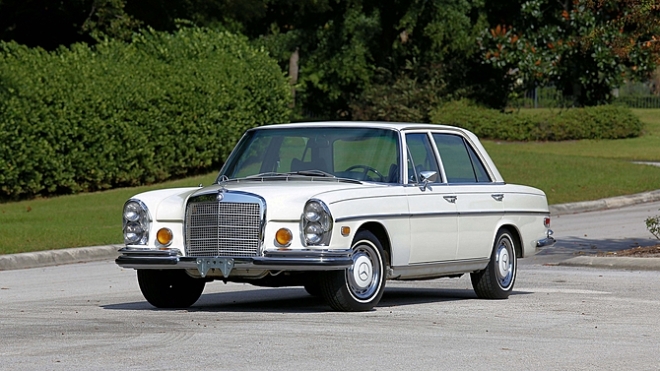
A recent spike in the value of the W108 saloons has brought them out in droves. But not all are quality examples. Some have succumbed to rust; others simply tired. Here is a very presentable 280 SEL with the 4.5-litre V8 that has excellent paint, glass, chrome and interior. It’s what one would expect of a 42,000-mile car. Some will appreciate the resistance to swap out the hubcaps steel wheels for the Bundt alloys, while others will appreciate a more modern (Becker) CD-based head unit. A timeless, classic big benz that can be enjoyed while a sound investment.
Lots K4, K5, K6, K7 – A Quartet of Low-Mileage Mercedes Benz 107s
moto+match estimate: $18,000-$35,000
UPDATE: Lot K4 – High bid at $43,000; Lot K5 – Sold for $40,000; Lot K5 – Sold for $22,000; Lot K6 – Sold for $13,500

The Mercedes-Benz 107 has had its ups and downs and, for the moment anyway, it seems to have settled at a reasonable level whereby higher-mileage driver quality examples can still be had for $10,000 or less while outstanding examples command outstanding prices. Here we have four of the latter. With the highest mileage car of the bunch (Lot K6 – 1986 560 SL) clocking just over 30,000 miles and two other 560 SLs yet to turn a fifth digit, it will be curious to see if this trio and its one-year-only fixed roof 380 SLC (with just over 20,000 miles) spur new interest in these look-rich-cheap classics.
Lot K26 – 1961 Mercedes-Benz 190 SL
moto+match estimate: $95,000
UPDATE: High bid of $90,000
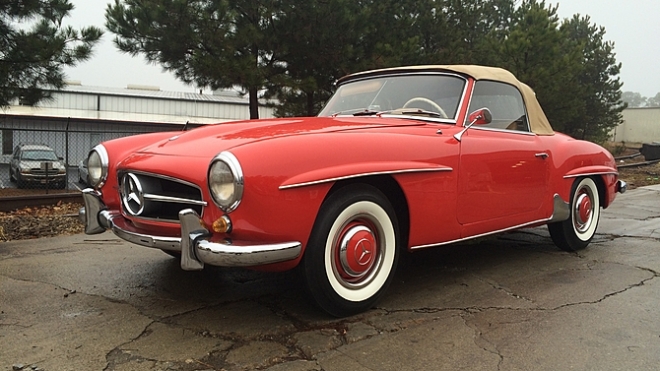
The Spring and Monterey auctions were very kind to the W121 190 SL. It’s not hard to see why. Bearing a familiar resemblance to the 300 SL, which is now in seven figures, this smaller, more “everyday” roadster exudes grace and style but with a definite sporting character. Its 1.9-liter four-cylinder won’t set any Nurburgring records, but, mated to its 4-speed manual gearbox, is more than capable along B roads on the way to brunch at the Club. We’ll have to see if Kissimmee as as favorable a venue as Monterey or Amelia, but they’re on a good wave. There likely won’t be many more opportunities to catch it before they chase their bigger sibling into the stratosphere.
Lot K99 – 1982 Toyota Land Cruiser FJ43
moto+match estimate: $35,000
UDATE: High bid of $35,000
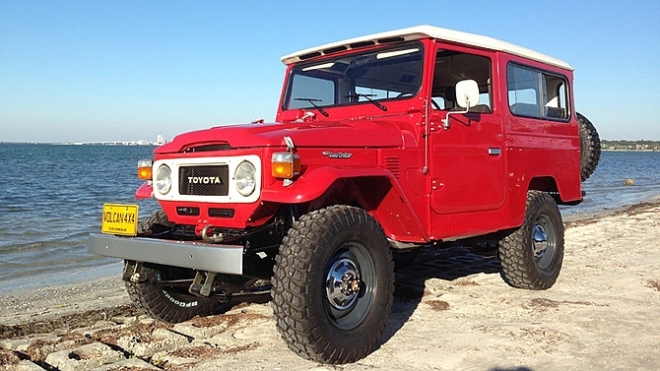
In a departure from the Mercedes-Benz parade, here’s something completely different but equally interesting. Unique among the Toyota FJ Land Cruisers is the mid-length FJ/BJ43. It’s longer than the Jeep-sized FJ40 that most of us are familiar, but not as long as the Troop Carriers. Even more unique is that most 43s were 2B- or 2H-diesel powered. Though never available through US dealers. a few have made their way up from Central and South America. This one appears to have undergone a high-quality restoration and while not entirely original, its modifications likely won’t detract from its crew among Land Cruiser enthusiasts. The vintage Land Cruiser market has tempered somewhat after a mid-2000s frenzy, but rare and well-sorted examples will always have an audience. It’s not unusual to see restored-to-showroom US-model FJ40s with the later-year (1980-1983) options like power steering and air conditioning (which imports like this FJ43 did not come with) reach or surpass the $50,000 mark. It’s unlikely this has the same kind of appreciation, but its rarity should attract some interest.
Lot K252 – 1969 Ford Torino Talladega
moto+match estimate: $45,000
The Ford Talladega was built over a very short period of time in early 1969 homologation special based on Ford’s Torino-based NASCAR entry that year. In total, only around 750 were built; just about a hundred more than the coveted Hemi ‘Cuda. On the track, the Superbirds and Daytonas obliterated them. In the aftermath, the Talladega faded into a near-obscure contender existence. At its heart though is a 428 Cobra Jet lump that Ford claims puts out 335 hp, but this was from the day when Ford and their Detroit counterparts would grossly understate horsepower figures. This is the same motor that propelled the Boss 429 to grail status among blue-chip collectors, but has largely remained overlooked in the Talladega, despite its more direct racing lineage. Not that long ago, a decent Talladega could be found for around $30,000. In the past year or so, its rarity and that motor have seen it climb sharply and there’s every indication it will continue to do so. While the automatic gearbox in this car will undoubtedly hold it back, it’s a very well sorted and documented example of Ford muscle car history.
Lot J50 – 1970 Honda 600
moto+match estimate: $15,000
UPDATE: Sold for $8,500
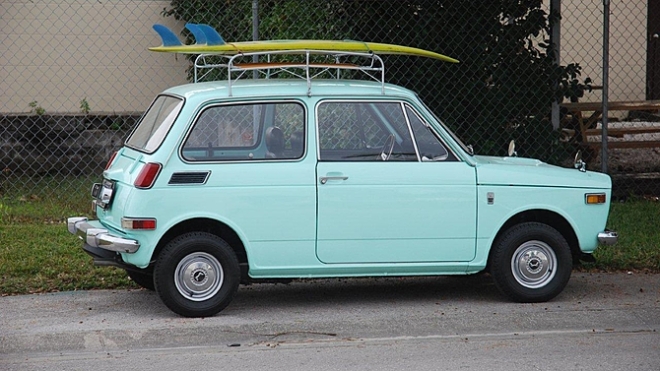
Two current trends—Japanese nostalgia and “cute”—converge in this 1970 Honda 600 2-door Coupe. While aftermarket parts such as the roof rack and modern stereo head unit have been added to make it a more enjoyable cars-n-coffee driver, it also appears that a great deal of attention has been paid to preserving the car’s original character. A comparable Beetle, Mini or Fiat 500 would easily approach or eclipse the $25K mark, while the early Honda remains somewhat of a sleeper.
Lot J54 – 1928 Ford Model A Woody Wagon
moto+match estimate: $28,000
UPDATE: High bid of $20,000
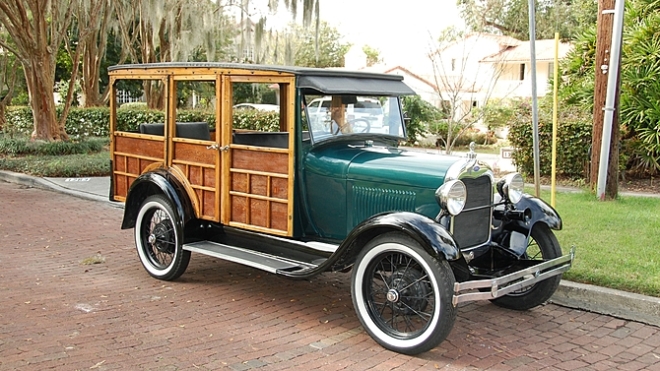
This Woody is hovering somewhere between partial restoration and original or older restoration. Nevertheless its rarity warrants completing the job and resisting any modifications. An early run number on the auction’s first day might also make bidding less competitive and could present an opportunity for a relative bargain.
Lot J56 – 1972 MG MGB MK III Roadster
moto+match estimate: $18,000
UPDATE: Sold for $9,500
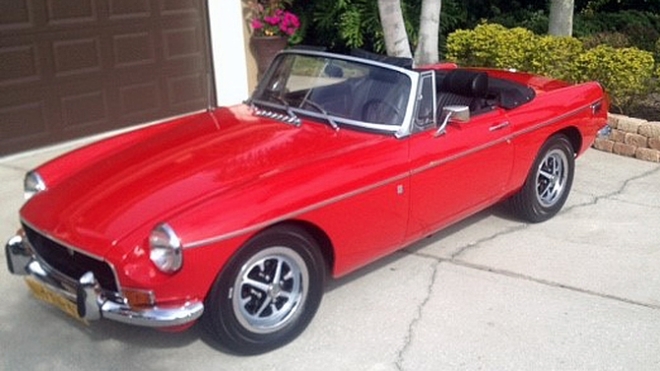
This is a case of an owner choosing to restore a car to a very high standard, but also to fit their tastes. It features an earlier MK II grille (yet curiously retains the Sabrina bumpers) as well as modified—i.e., better—electrical, carburetion, suspension, and brakes. These are relatively easy things to correct, should instant owner desire a black-letter restoration. It also has the optional aluminum hood, but does not appear to have overdrive. Although British roadsters have been on a slight decline since peaking a year ago, this is a quality B that could still prove to be an excellent long-term investment whilst enjoying sensible everyday improvements.
Lot J116 – 1969 Chevrolet Camaro SS
moto+match estimate: $36,000
UPDATE: Sold for $38,000
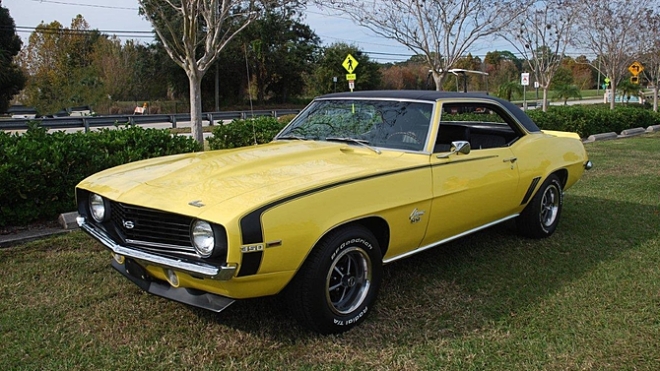
One wouldn‘t expect to come across a ‘69 Camaro SS—especially one that appears to be done to a higher standard—on the first day of a 10-day auction, yet here it is. True, it doesn‘t have the cachet of its L89 or L78 siblings, but the L48 350 is a perfectly capable powerplant. Mated to what looks to be a Muncie M-21 4-speed, this has everything anyone wishing to get into American Muscle or HiPony cars could ask for. It‘s modestly optioned with a houndstooth interior, power steering, SS wheels, etc. and presents itself in a very appealing Daytona Yellow/Black color combination, along with its hockey stripe and vinyl roof. Relative to what may come later in the week—not to mention at the Arizona auctions—this could turn out to be a gem.
Lot J138 – 1985 BMW M6
moto+match estimate: $28,000
UPDATE: High bid of $22,500
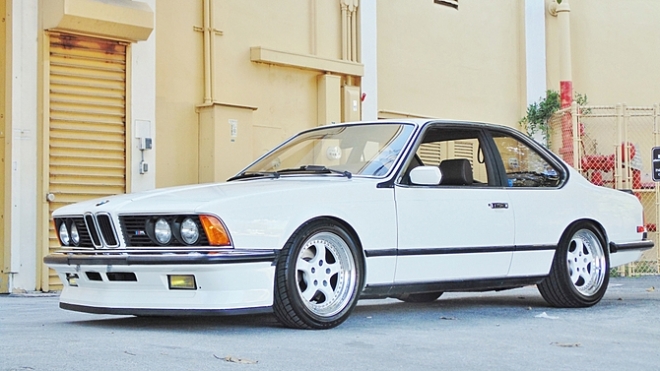
At first glance it might be easy to pass this one over as a nice-but-nothing-special E24 M6, as it‘s labeled in the catalog. Astute observers, however, will take note that US sales of the M6 didn‘t start until two years later, as a 1987 model. A closer look reveals that this is in fact a European M635CSi. This is significant in that the Euro version is powered by the quasi-exotic M1’s M88, which has an output of nearly 300 hp. The M635CSi also had optional buffalo leather seating (as this car does) whereas we got Nappa leather on US cars. As it was only built for two years, with some trickling into 1989, the M6 has much lower production numbers (1,767 vs. 4,088 of the M635CSi). However, the direct legacy to the M1 and its rarity in the US make the M635CSi a special find. The color-matched Speedline wheels aren’t to everyone’s taste, nor are they correct (unique 390mm BBS shod with Michelin TRX), but they are more practical for everyday use. Mecum does not publish odometer readings (except in outstanding cases), but its appearance is that of a well-cared for example. Its catalog misprint, early showing and that it’s not the typical Mecum fare (although they have been very good lately about adding more to the “Muscle Cars and More” maxim) could present an extraordinary opportunity.














































































